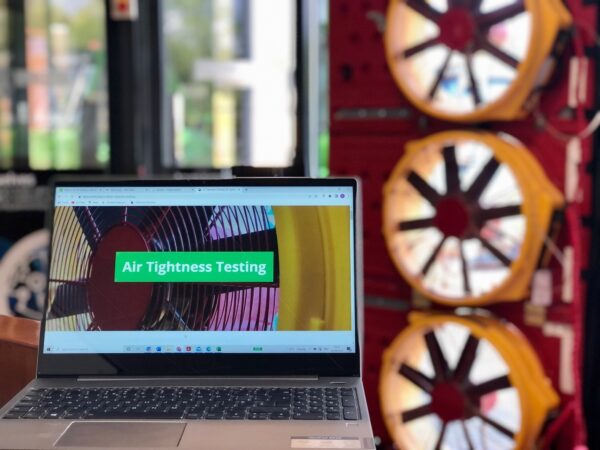The Importance of Air tightness testing cannot be underestimated. Blower door testing is a technique that can be used to quantify the amount of air leakage of a building fabric. The air tightness test measures the rate of air leakage through a building fabric by pressurising or depressurising a building and measuring the difference in pressure across different sections of wall, floor and roof, or the building envelope as its also called.
The test is undertaken by measuring the pressure difference between inside and outside the building, when all external doors and windows are closed and all internal doors are open.

Air Tightness Testing can help lower energy Costs
Air leakage is a major issue for homeowners, especially in light of the rising heating and cooling costs across the UK and Europe. Air leakage can lead to higher energy consumption, higher carbon emissions and indoor air quality issues.
It is important to identify the location of the air leakage so that it can be fixed effectively. We can undertake a detailed smoke leakage survey which details each air leakage paths within the building envelope, so these can be sealed to lower the air leakage rate of dwellings. Air tightness and smoke testing is especially useful for identifying leaks in buildings, identifying areas where there are problems with insulation or drywall, identifying where windows and doors leak air, etc.
Air Tightness testing is low impact
Air leakage testing is a non-invasive technique, that is a quick and very low impact and is undertaken at the end of the construction process just prior to building handover. It is also known blower door testing and air leakage testing. We always send out an air tightness checklist to help you prepare for the test, so you have a better chance of passing first time for compliance with Building Regulations Part L.
Air tightness testing is done by pressurising and depressurising the building enclosure with a fan and measuring the pressure difference with a manometer or mass flow meter. The pressure difference indicates the amount of air leakage in the building fabric and gives you a reading in m3/hr/m2.
The blower door test can be used to identify leaks in ductwork, windows, doors, roofs, walls, and floor assemblies. Air tightness tests are useful for preventing moisture problems such as mould growth.
If you fail your air tightness test don’t panic, we can visit site and help you pass your air tightness test.

We can help with your air tightness test
At APT Sound Testing we have large amount of experience in understanding the requirements of Approved Document L, along with extensive experience of carrying out thousands of successful air tightness tests on a wide range of developments across London and the UK. By working with our customers at the design and construction stages we provide advice and guidance on the most feasible ways to avoid air leakage and attain compliance for the air tightness test.
Please download our air tightness checklist for more information on how to prepare your building for the air tightness test.
At APT Sound Testing, we are happy to provide you with general air leakage design advice for your building envelope and onsite guidance. Upon completion of your project, we provide Nationwide UKAS Accredited Tightness Testing for domestic and commercial buildings to help you demonstrate Building Regulation Part L Compliance.
To find out more about our air tightness testing service or if you wish to discuss your project please contact us on 01525 303905 or email us at info@aptoundtesting.co.uk
